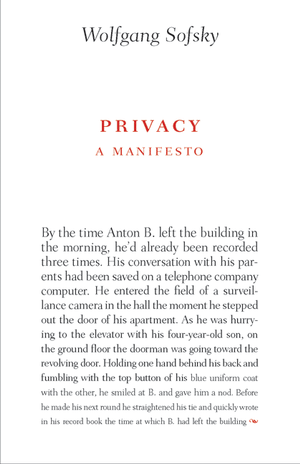
Privacy: A Manifesto
by Wolfgang Sofsky
The design of Wolfgang Sofsky’s little white book on privacy is unusual. Placing the first paragraph on the cover seems somehow perverse, suggestive of the sort of invasion and exposure that the book seeks to condemn. The title, too, has a sense of dissonance: the subject of privacy discussed in something called a “manifesto,” which literally means to make public.
The insides of this timely book can be surprising as well. Sofsky initially seems to be taking the easy road – condemning state and corporate intrusions into private acts – but he goes somewhere more interesting. He blames individuals too comfortable with conformity and transparency for the decline in privacy.
Sofsky presents a densely-packed meditation on privacy, including even a discussion of its age-old sources – the hiding of the naked body and its functions, the invention of private property – and continuing on to analyze our modern data-driven state. For those readers accustomed to anodyne discussions of the seemingly harmless camera in a corner, Sofsky’s focus on the body gives a broader understanding of privacy, and a more visceral response to its violation by arrest, airport pat-down, search and seizure, wire tap and security camera. Of an arrestee, Sofsky writes vividly, “…his body is put in restraints. Power is not content with symbols alone. Freedom of movement is denied, the taboo on touching is lifted. It is permissible to do things to the body of a person under arrest that would immediately arouse loud protests in civil life.” Sofsky discusses too the more common intrusion, that lingering “unpleasant feeling” of strangers rifling through private possessions or eyeballing x-ray images.
Security-driven invasions of privacy may get the most chatter these days, but as Sofsky notes, governments and other institutions have further reasons for needing information. Welfare and healthcare programs require data. Financial records must be revealed for tax collection, which Sofsky calls “an arbitrary act, a contribution without equivalent, and an inexhaustible resource for state power.” To be competitive, companies need to know their customers’ habits. Daycares set up cameras for parents to watch remotely. Deaths and births, Sofsky writes, were once entirely private happenings, and are now well-regulated and occur in hospitals. (So suicide remains for Sofsky “the most private act of all, an antisocial act par excellence.”) And though pain and addiction remain private matters – if only because of our inability to articulate them – treatment and detoxification is observed.
What seems to have lulled us into some complacence, Sofsky suggests, is that data evaluation and compilation lags behind data collection. Combined, he notes, “offices hold immense knowledge.” But so far, information is largely uncombined or even unanalyzed. And in any case, bureaucratic institutions may be a lesser threat than our own tendency to conform, Sofsky suggests. The “moral cowards” among us adhere to national and religious dogmas, to stick to the opinions of our friends and families. Unable to cultivate private thoughts, they become “fully transparent,” making observation unnecessary.
Excerpt: “Once a regime was considered totalitarian if it occupied all areas of social life. Modern bio-power does not limit itself to controlling social relationships. It grasps humans as organic, living beings. Even before the first breath is drawn, bio-power seizes control over the body, granting and refusing the right to life. This soft, law-abiding totalitarianism destroys private existence in its physical center, in the inviolability of the body and human nature.”
Further Reading: A History of Private Life, Volumes I through V and The Value of Privacy




Send A Letter To the Editors